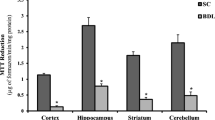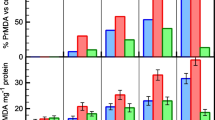Abstract
Ammonia is neurotoxic and believed to play a major role in the pathogenesis of hepatic encephalopathy (HE). It has been demonstrated, in vitro and in vivo, that acute and high ammonia treatment induces oxidative stress. Reactive oxygen species (ROS) are highly reactive and can lead to oxidization of proteins resulting in protein damage. The present study was aimed to assess oxidative status of proteins in plasma and brain (frontal cortex) of rats with 4-week portacaval anastomosis (PCA). Markers of oxidative stress, 4-hydroxy-2-nonenal (HNE) and carbonylation were evaluated by immunoblotting in plasma and frontal cortex. Western blot analysis did not demonstrate a significant difference in either HNE-linked or carbonyl derivatives on proteins between PCA and sham-operated control rats in both plasma and frontal cortex. The present study suggests PCA-induced hyperammonemia does not lead to systemic or central oxidative stress.



Similar content being viewed by others
References
Blendis L (2006) Hepatic encephalopathy forward to the past. Gastroenterology 130:2239–2240
Bosoi CR, Rose CF (2009) Identifying the direct effects of ammonia on the brain. Metab Brain Dis 24:95–102
Bruck R, Aeed H, Shirin H, Matas Z, Zaidel L, Avni Y, Halpern Z (1999) The hydroxyl radical scavengers dimethylsulfoxide and dimethylthiourea protect rats against thioacetamide- induced fulminant hepatic failure. J Hepatol 31:27–38
Butterworth RF (2003) Hepatic encephalopathy-a serious complication of alcoholic liver disease. Alcohol Res Health 27:143–145
Butterworth RF, Norenberg MD, Felipo V, Ferenci P, Albrecht J, Blei AT (2009) Experimental models of hepatic encephalopathy: ISHEN guidelines. Liver Int 29:783–788
Choi JH, Yu BP (1995) Brain synaptosomal aging: free radicals and membrane fluidity. Free Radic Biol Med 18:133–139
Felipo V, Butterworth RF (2002) Neurobiology of ammonia. Prog Neurobiol 67:259–279
Guerrini VH (1994) Effect of antioxidants on ammonia induced CNS-renal pathobiology in sheep. Free Radic Res 21:35–43
Hazell AS, Butterworth RF (1999) Hepatic encephalopathy: an update of pathophysiologic mechanisms. Proc Soc Exp Biol Med 222:99–112
Hilgier W, Anderzhanova E, Oja SS, Saransaari P, Albrecht J (2003) Taurine reduces ammonia- and N-methyl-D-aspartate-induced accumulation of cyclic GMP and hydroxyl radicals in microdialysates of the rat striatum. Eur J Pharmacol 468:21–25
Kosenko E, Venediktova N, Kaminsky Y, Montoliu C, Felipo V (2003) Sources of oxygen radicals in brain in acute ammonia intoxication in vivo. Brain Res 981:193–200
Lee SH, Fisher B (1961) Portacaval shunt in the rat. Surgery 50:668–672
Lowry OH, Rosebrough NJ, Farr AL, Randall RJ (1951) Protein measurement with the Folin phenol reagent. J Biol Chem 193:265–275
Masson S, Mardini HA, Rose JD, Record CO (2008) Hepatic encephalopathy after transjugular intrahepatic portosystemic shunt insertion: a decade of experience. QJM 101:493–501
Norenberg MD, Jayakumar AR, Rama Rao KV (2004) Oxidative stress in the pathogenesis of hepatic encephalopathy. Metab Brain Dis 19:313–329
Norenberg MD, Jayakumar AR, Rama Rao KV, Panickar KS (2007) New concepts in the mechanism of ammonia-induced astrocyte swelling. Metab Brain Dis 22:219–234
Poon HF, Calabrese V, Scapagnini G, Butterfield DA (2004) Free radicals and brain aging. Clin Geriatr Med 20:329–359
Reddy PVB, Murthy CRK, Reddanna P (2004) Fulminant hepatic failure induced oxidative stress in nonsynaptic mitochondria of cerebral cortex in rats. Neurosci Lett 368:15–20
Sathyasaikumar KV, Swapna I, Reddy PVB, Murthy CRK, Dutta Gupta A, Senthilkumaran B, Reddanna P (2007) Fulminant hepatic failure in rats induces oxidative stress differentially in cerebral cortex, cerebellum and pons medulla. Neurochem Res 32:517–524
Schliess F, Görg B, Fischer R, Desjardins P, Bidmon HJ, Herrmann A, Butterwort RF, Zilles K, Häussinger D (2002) Ammonia induces MK-801-sensitive nitration and phosphorylation of protein tyrosine residues in rat astrocytes. FASEB J 16:739–741
Stadtman ER, Levine RL (2003) Free radical-mediated oxidation of free amino acids and amino acid residues in proteins. Amino Acids 25:207–218
Warskulat U, Görg B, Bidmon H, Müller HW, Schliess F, Häussinger D (2002) Ammonia-induced heme oxygenase-1 expression in cultured rat astrocytes and rat brain in vivo. Glia 40:324–336
Widmer R, Kaiser B, Engels M, Jung T, Grune T (2007) Hyperammonemia causes protein oxidation and enhanced proteasomal activity in response to mitochondria-mediated oxidative stress in rat primary astrocytes. Arch Biochem Biophys 464:1–11
Author information
Authors and Affiliations
Corresponding author
Rights and permissions
About this article
Cite this article
Yang, X., Bosoi, C.R., Jiang, W. et al. Portacaval anastomosis-induced hyperammonemia does not lead to oxidative stress. Metab Brain Dis 25, 11–15 (2010). https://doi.org/10.1007/s11011-010-9174-1
Received:
Accepted:
Published:
Issue Date:
DOI: https://doi.org/10.1007/s11011-010-9174-1




